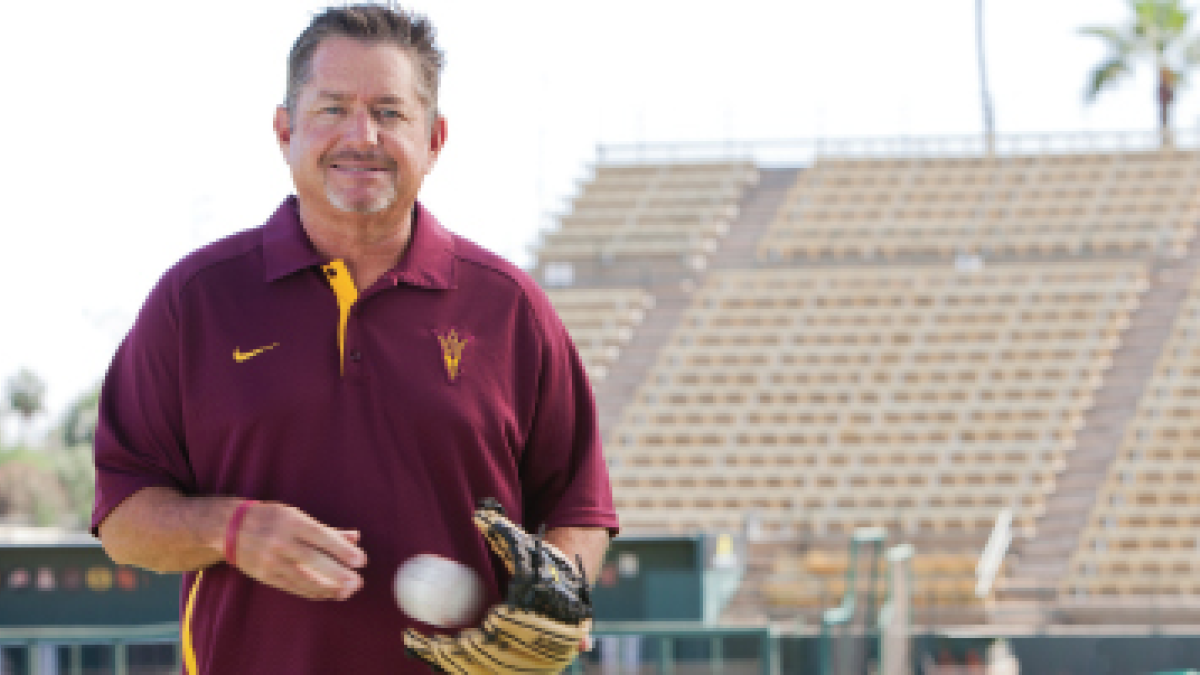Good catch: ASU baseball sends 100th player to the major leagues

Editor's Note: This story originally appeared in the December 2012 edition of ASU Magazine.
In his first Major League Baseball (MLB) game, Kole Calhoun didn’t swing a bat. He didn’t make a defensive play. But he did make history.
On May 22, Calhoun became the 100th former Sun Devil to play in the majors when he entered as a defensive substitution in the ninth inning of the Los Angeles Angels’ 5-0 win over the Oakland Athletics. One day earlier, he placed an important phone call to his college coach.
“You get goose bumps when the phone rings and it’s (Andrew) Romine or (Eric) Sogard or Calhoun to tell you that they got called up to the big leagues,” ASU coach Tim Esmay said. “You get chills. You hear that little kid excitement in their voice. ‘Can you believe it? I’m going to the big leagues.’ That’ll never get old.”
ASU coaches have received more than their share of such calls. Since baseball became a varsity sport at ASU in 1959, only two other schools have produced as many major leaguers. Only USC’s 106 and Texas’s 105 best ASU’s all-time mark, which increased to 101 when infielder Jake Elmore debuted with the Diamondbacks on Aug. 11.
“Arizona State is one of the brand names in college baseball,” said journalist Will Kimmey, who spent the last decade covering college baseball for Baseball America and ESPN. “If you follow the College World Series, you’re used to seeing the gold and maroon. In basketball, it’s North Carolina and Duke. In baseball, it’s Arizona State and USC and Texas.”
Former Sun Devils have won a combined nine major league MVP awards and 53 Sun Devils have appeared in the MLB All-Star Game. The list of greats includes home run king Barry Bonds, Hall of Fame member Reggie Jackson, and three-time World Series champion Sal Bando.
What is it that draws major league talent to Tempe? There’s the reputation for preparing alumni for pro ball. There’s the tradition of five national championships and 22 College World Series appearances. And there’s the year-round baseball weather. Plus, it’s a great place to hit. The desert air is dry, so wellstruck balls carry over the fence. And Packard Stadium is large (338 feet down the lines, 368 in the power alleys, and 395 to center), so balls that don’t clear the fence more easily find a gap between outfielders. “If you’re a hitter, you want to play in that kind of park,” Kimmey said.
ASU had at least one future major leaguer on its roster every season from 1961 through 2010. It’s the longest such streak in the nation.
The pace really picked up during the latter stages of former coach Pat Murphy’s tenure. From 2006 to 2010, 15 Sun Devils made their MLB debuts. It was the program’s most prolific five-year stretch since the late Jim Brock placed 17 Sun Devils in the majors from 1980 to 1984.
Some players looked like big leaguers from day one on campus.
Take Mets first baseman Ike Davis. He was rated the No. 2 freshman in college baseball before taking the mound and hitting cleanup in his first collegiate game. He made his MLB debut in the first month of his second full professional season in 2010.
Or Reds pitcher Mike Leake. He set multiple freshman records en route to a 13-2 mark in 2007. In 2010, he became the first player to bypass the minors since 2000 and the first pitcher to do so since 1989.
Others snuck into the majors through the backdoor. Murphy gave Athletics infielder Sogard the nickname “Soda Boy” when his primary role as a freshman was to keep Murphy’s supply of Diet Dr. Pepper stocked. Indians second baseman Jason Kipnis started his college career at Kentucky. Upon transferring to ASU, he played exclusively in the outfield – a position for which he was deemed too slow by MLB scouts.
And then there’s Calhoun. Big Red was not selected in the 2009 major league draft. He used the snub as motivation for a mesmerizing College World Series in which he batted .563 with three home runs and 11 RBIs. The power surge continued into his senior season when he was drafted by the Angels.
As a coach, Esmay is satisfied to know he played a role in developing so many student-athletes for their chosen professions. As an ASU graduate and Sun Devil fan, he’s just glad to see so many familiar faces on his television.
“I watch the MLB package at home pretty much every night,” Esmay said. “People ask what my favorite team is. I say whoever has a Sun Devil in the lineup when I’m watching.”
The ASU Alumni Association and the Sun Devil Club will host a special alumni weekend celebrating Sun Devil baseball, with a dinner on Feb. 9, 2013, as well as other activities. For details, visit alumni.asu.edu/baseball.
Written by Matt Simpson, who is a Phoenix-based freelance sportswriter.